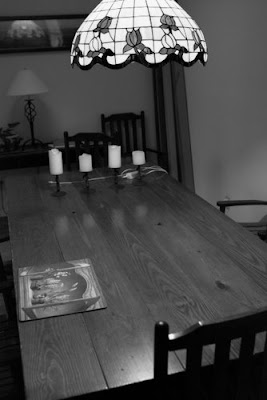Nikon's newer - and much, much more expensive - full-frame cameras can do even better than the K20D, even at higher ISOs. From what I've read, I gather that ISO 6400 on a Nikon D3 resembles what you get at ISO 1600 on a Pentax K20D - a full two-stop difference. That's nice. But I don't need a Nikon D3 and don't want to pay through the nose for one. If I were a millionaire, I might. If I were shooting magazine covers, I might - although it's even more likely that I'd be shooting medium-format and getting even less noise than the D3.
There's always a compromise. There is no compact full-frame digital camera that shoots without making a sound and returns virtually noiseless photos at, say, ISO 6400. Every camera involves a compromise. You want lower noise? You pay for it by buying a camera with a larger sensor. Compact cameras like my old Canon PowerShot S5 can take truly wonderful photographs, but they're simply not designed to deal with extreme exposure challenges. That's not a liability, it's a compromise. The compact cameras are smaller, quieter, and cost less than either APS-C sized or full-frame digital SLRs. You want even lower noise than you get from a K20D? The Canon 5D (full frame) is still available but getting a bit long in the tooth; the newer Nikon full-frame cameras are nice but really expensive.
I don't want a perfect camera. Well, I want one, but it doesn't exist. So I compromise. What can I afford? And what will do a good enough job for me? To be honest, if I could make just one change to the Pentax K20D and it was either (a) fantastic performance at ISO 6400 or (b) a noiseless shutter, I'd go for (b).
And the K20D's performance at higher ISOs is stunningly good, if you use a reasonable, historical baseline for comparison. Here for example, is a shot taken at ISO 6400, with in-camera noise reduction set to "high".

It's hard to tell from this photo, but trust me, it's not bad at all. If for some reason you were motivated to waste paper on this boring photo, it would produce a nice print at normal print sizes like 4"x6", 5"x7", perhaps even larger. You can click on the picture to view a few photos from the same brief test.
Like most of my tests, the test shots I took this morning of my dining room table don't prove a lot, except that ISO 6400 on the K20D can actually produce a usable image, in the right circumstances. Unfortunately, I do know that the results I've gotten at high ISOs - that is, shooting at sensitivity levels higher than about 800 - is quite variable. I cannot entirely explain the factors that make a difference here, but I've take shots at ISO 1600 that are much noisier than this shot taken at 6400. The amount of light seems to matter, and so does the quality of light. The nature of the objects being photographed matters a lot. Objects with some variation in them seem to show noise less than areas of the photo with little variation, like walls or large shadowy areas. If I do get an irresistible desire to start photographing blank walls in the dark, I'll look into the Nikon D3X. But for now, my K20D meets these challenges satisfactorily. And when the light is decent, which is most of the time, the results I get are, as a practical matter, every bit as good as those I'd get from a full-frame camera.
![William Porter Photography [2009-10]](https://blogger.googleusercontent.com/img/b/R29vZ2xl/AVvXsEivarWsIzJ4UBGkZm5Bhjfzd86M8FVCsnN6XYKbLreeu9ClcuVDhxQ01Et3CzACm0EEmSb8ysiGiONwchtch3c20CgUQJTV0GhZh5C0Bd-1DfUo29rk-UeOlREIxl8OTd1T3kNrMWHre3EV/s1600/GOOGLE+320x132.png)